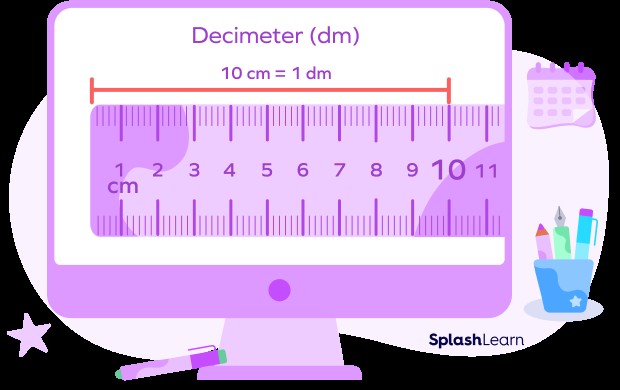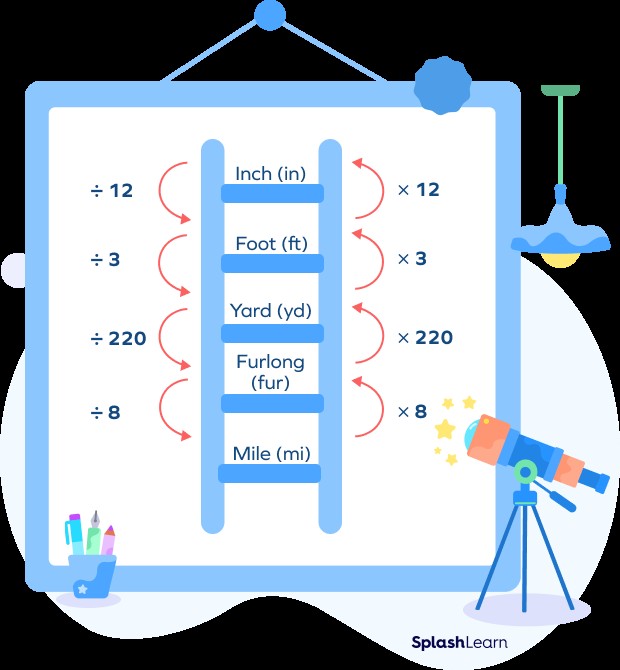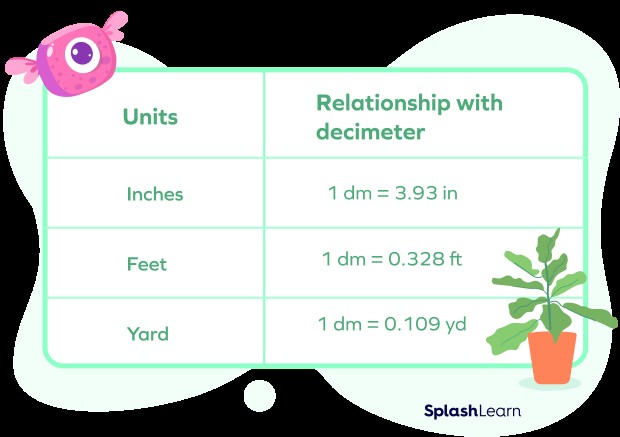Decimeter Definition: Are you curious about understanding the metric system and its length measurements? At WHAT.EDU.VN, we clarify concepts like the decimeter and explore its importance. This guide explains what a decimeter is, how it relates to other metric units, and its practical applications. Delve into the world of metric conversions, measurements, and volume with us!
1. Understanding the Decimeter: A Comprehensive Guide
What exactly is a decimeter? A decimeter is a unit of length within the metric system, crucial for accurate measurements. Let’s break it down in simple terms:
-
Definition: A decimeter (dm) is a unit of length equal to one-tenth of a meter. The prefix “deci” comes from the Latin word “decimus,” meaning one-tenth.
-
Symbol: The symbol for decimeter is “dm.”
Think of a meter stick. If you divide that meter stick into ten equal parts, each part is a decimeter. This relationship is essential for metric unit conversion and understanding measurements.
2. How Long is a Decimeter? Visualizing the Length
To truly grasp the concept of a decimeter, let’s visualize its length compared to other common units:
- Relationship to Centimeters: 1 decimeter equals 10 centimeters (cm). This is because a meter is divided into 100 centimeters, so one-tenth of a meter is 10 centimeters.
- Relationship to Millimeters: 1 decimeter equals 100 millimeters (mm). There are 1000 millimeters in a meter.
- Comparison: A decimeter is larger than a centimeter but smaller than a meter, making it a handy unit for measuring medium-sized objects.
Consider a standard-sized smartphone. Its length is often around 1.5 decimeters. This helps to put the measurement into perspective.
3. The Metric System: A Foundation for Decimeters
The metric system is a decimal system of measurement based on powers of ten. This makes conversions straightforward and logical. Here’s why it’s essential to understand the metric system:
- Base Units: The primary units are the meter (m) for length, the liter (L) for volume, and the gram (g) for mass.
- Prefixes: Prefixes like “deci,” “centi,” “milli,” “kilo,” etc., are added to the base units to denote larger or smaller quantities. Understanding these prefixes is crucial for conversions.
- Universality: The metric system is used worldwide, making it a standard for scientific and technical measurements. Unlike customary units, the metric system simplifies calculations and ensures consistency.
For example, 1 kilometer is 1000 meters, and 1 millimeter is 1/1000 of a meter. The beauty of the metric system lies in its simplicity and ease of conversion.
4. Decimeters and Other Metric Units: A Conversion Table
Understanding how decimeters relate to other metric units is key. Here’s a handy conversion table:
| Unit | Symbol | Equivalent to |
|---|---|---|
| Kilometer | km | 10,000 dm |
| Hectometer | hm | 1,000 dm |
| Decameter | dam | 100 dm |
| Meter | m | 10 dm |
| Decimeter | dm | 1 dm |
| Centimeter | cm | 0.1 dm |
| Millimeter | mm | 0.01 dm |





This table illustrates how easy it is to convert between units in the metric system. For instance, if you want to convert meters to decimeters, you simply multiply by 10. Conversely, to convert decimeters to meters, you divide by 10.
5. Decimeters and Imperial/US Customary Units: Bridging the Gap
While the metric system is dominant worldwide, some countries, like the United States, still use imperial or US customary units. Here’s how decimeters relate to these units:
| Unit | Equivalent to |
|---|---|
| Inch | Approximately 0.254 dm |
| Foot | Approximately 3.048 dm |
| Yard | Approximately 9.144 dm |
| Mile | Approximately 160,934.4 dm |
For practical conversions:
- 1 decimeter is about 3.94 inches.
- 1 foot is roughly equivalent to 3 decimeters.
Knowing these conversions helps in contexts where both systems are used. For example, in construction or engineering, it might be necessary to convert between inches and decimeters for accuracy.
6. Decimeters and Liters: Understanding Volume
Volume, or the amount of space an object occupies, is closely related to length measurements. In the metric system, liters (L) are used to measure volume. Here’s how decimeters come into play:
- Cubic Decimeter: A liter is defined as the volume of a cube that measures 1 decimeter on each side. Therefore, 1 liter = 1 cubic decimeter (1 dm³).
- Relationship: This relationship is fundamental in chemistry and physics for calculating densities and concentrations.
Imagine a cube with each side measuring 1 decimeter. The amount of water that fills that cube is exactly 1 liter.
7. Practical Applications of Decimeters: Where Are They Used?
Decimeters, while not as commonly used in everyday life as centimeters or meters, have specific applications:
- Technical Fields: In engineering, manufacturing, and construction, decimeters offer a balance between precision and ease of use for medium-sized measurements.
- Scientific Research: In scientific contexts, decimeters can be used for measuring volumes, areas, and lengths in experiments and data collection.
- Education: Decimeters are valuable in teaching the metric system, providing a stepping stone between smaller and larger units.
Consider a laboratory setting where a scientist needs to measure the dimensions of a container. Using decimeters can provide a convenient and accurate measurement without resorting to smaller units like centimeters or larger units like meters.
8. Fun Facts About Decimeters: Interesting Tidbits
- Position in Metric Scale: A decimeter is larger than a millimeter and centimeter but smaller than a meter.
- Historical Context: The metric system was developed in France in the late 18th century to standardize measurements.
- Everyday Examples: While not commonly spoken, you might encounter decimeters in detailed technical specifications or scientific reports.
Understanding these fun facts helps to contextualize the decimeter within the broader framework of measurement systems.
9. Solved Examples: Mastering Decimeter Conversions
Let’s work through some examples to solidify your understanding:
Example 1: Convert 2.5 dm to centimeters.
- Solution: Since 1 dm = 10 cm, 2.5 dm = 2.5 × 10 cm = 25 cm.
Example 2: Convert 75 meters to decimeters.
- Solution: Since 1 m = 10 dm, 75 m = 75 × 10 dm = 750 dm.
Example 3: Compare 6 m and 45 dm.
- Solution: Convert 6 m to decimeters: 6 m = 6 × 10 dm = 60 dm. Therefore, 6 m (60 dm) > 45 dm.
Example 4: Which is longer: a 30 dm stick, a 250 cm rope, or a 2 m string?
- Solution: Convert all to decimeters: 30 dm = 30 dm, 250 cm = 25 dm, 2 m = 20 dm. Therefore, the 30 dm stick is the longest.
Example 5: Convert 2 feet to decimeters.
- Solution: Since 1 foot ≈ 3.048 dm, 2 feet ≈ 2 × 3.048 dm = 6.096 dm.
10. Practice Problems: Test Your Knowledge
Test your understanding with these practice problems:
- Convert 15 hectometers to decimeters.
- Convert 4000 dm to decameters.
- Which is the shortest: 60 cm, 4 m, 70 mm, or 50 dm?
- Lisa has a green ribbon that’s 3 dm long. Ben has a yellow ribbon that’s 20 cm long. Tom has a purple ribbon that’s 0.3 m long. What is the total length of the ribbons?
- Select the symbol that makes the statement true: 30 dm _ 30 dm = 6 m
Image alt text: A sample quiz question about decimeters, testing understanding of metric conversions.
11. Frequently Asked Questions (FAQs) about Decimeters
To further clarify any lingering questions, here are some frequently asked questions:
Q1: How many decimeters are in a meter stick?
- A: A meter stick is 1 meter long, so there are 10 decimeters in a meter stick.
Q2: Which is larger: a decimeter or a decameter?
- A: A decameter is larger. “Deci” means one-tenth, while “deca” means ten times.
Q3: How many inches are in one decimeter?
- A: One decimeter is approximately 3.937 inches. According to the National Institute of Standards and Technology (NIST), precise conversion is essential in engineering and science.
Q4: Is a decimeter bigger than a centimeter?
- A: Yes, a decimeter is bigger than a centimeter. A decimeter is one-tenth of a meter, while a centimeter is one-hundredth of a meter.
Q5: How can decimeters be used in real-world applications?
- A: Decimeters are used in fields requiring precise medium-sized measurements, such as engineering, construction, and scientific research.
Answering these common questions provides a comprehensive understanding of decimeters and their relevance.
12. The Importance of Accurate Measurement: Why Decimeters Matter
Accurate measurement is critical in various fields, from construction to medicine. Decimeters play a role in ensuring precision where medium-sized units are necessary:
- Construction: Accurate measurements ensure buildings are structurally sound and meet design specifications.
- Manufacturing: Precise measurements are essential for producing parts that fit together correctly.
- Science: Accurate measurements are the foundation of reliable experiments and data analysis.
- Medicine: Precise measurements are crucial for administering medications and treatments.
For example, consider a civil engineer designing a bridge. Accurate measurements in decimeters can help ensure that components fit together perfectly, ensuring the bridge’s stability and safety.
13. Converting Between Units: Tips and Tricks
Converting between metric units doesn’t have to be daunting. Here are some tips and tricks to make it easier:
- Use Conversion Tables: Keep a conversion table handy for quick reference.
- Understand Prefixes: Memorize the prefixes and their meanings (kilo, hecto, deca, deci, centi, milli).
- Move the Decimal: When converting between units, move the decimal point according to the power of ten.
- Practice: Practice converting units regularly to build confidence.
For instance, to convert kilometers to millimeters, remember that “kilo” means 1000 and “milli” means 1/1000. Therefore, you would multiply by 1,000,000 (1000 x 1000).
14. Further Exploration: Resources for Learning More
Want to dive deeper into the world of measurements? Here are some resources to explore:
- Online Conversion Tools: Websites like ConvertUnits.com and UnitConverters.net provide easy-to-use conversion tools.
- Educational Websites: Khan Academy offers free lessons on the metric system and unit conversions.
- Textbooks: Physics and engineering textbooks often include detailed explanations of measurement systems.
- Standards Organizations: The International Bureau of Weights and Measures (BIPM) provides information on the metric system.
Exploring these resources will enhance your understanding of measurement systems and their applications.
15. Decimeters in Everyday Life: More Than Just a Unit
While you may not explicitly use decimeters every day, understanding them enhances your overall knowledge of measurements:
- Home Improvement: When measuring spaces for furniture or renovations, knowing how decimeters relate to other units can be helpful.
- Cooking: In recipes that use metric units, understanding conversions can improve accuracy.
- Travel: When traveling to countries that use the metric system, knowing conversions can make daily tasks easier.
- Understanding News: When reading about scientific or technical topics, understanding metric units is essential for comprehension.
For example, when buying a rug for your living room, knowing that a meter is about 3.3 decimeters can help you visualize the size of the rug in relation to the room.
16. Common Mistakes to Avoid: Ensuring Accurate Conversions
Even with a good understanding of decimeters, it’s easy to make mistakes. Here are some common pitfalls to avoid:
- Incorrect Prefix Usage: Confusing “deci” with “deca” can lead to errors.
- Decimal Placement: Misplacing the decimal point during conversions is a common mistake.
- Forgetting Units: Always include the units in your calculations to avoid confusion.
- Ignoring Significant Figures: In scientific calculations, pay attention to significant figures.
For instance, if you’re converting 5 meters to centimeters, remember that 1 meter is 100 centimeters. Multiplying 5 by 10 instead of 100 will result in an incorrect answer.
17. Advanced Applications: Decimeters in Science and Engineering
In advanced fields, decimeters play a crucial role in precise measurements and calculations:
- Physics: In physics, decimeters are used in experiments involving wavelengths, amplitudes, and other measurements.
- Chemistry: In chemistry, decimeters are used to measure volumes of liquids and concentrations of solutions.
- Engineering: In engineering, decimeters are used in designing structures, machines, and electronic devices.
For example, a chemist might use decimeters to measure the dimensions of a reaction vessel to calculate the volume of reactants needed for an experiment.
18. The Future of Measurement: The Ongoing Evolution of the Metric System
The metric system is constantly evolving to meet the needs of modern science and technology:
- Redefinition of Base Units: In recent years, the base units of the metric system have been redefined based on fundamental constants of nature.
- Improved Accuracy: Efforts are ongoing to improve the accuracy and precision of measurements.
- Adoption Worldwide: The metric system is becoming increasingly adopted worldwide as the standard for measurement.
The International System of Units (SI), which is the modern form of the metric system, is continually updated to ensure its relevance and accuracy.
19. Engaging Activities: Making Learning Fun
To make learning about decimeters more engaging, try these activities:
- Measurement Scavenger Hunt: Find objects around your home and measure them in decimeters.
- Conversion Challenges: Challenge your friends to convert between different units.
- Online Quizzes: Take online quizzes to test your knowledge.
- DIY Projects: Build a small project that requires accurate measurements in decimeters.
These activities will help you apply your knowledge and make learning more enjoyable.
20. Decimeters and Digital Tools: Leveraging Technology
Today, technology offers various tools for working with decimeters:
- Mobile Apps: Numerous mobile apps can convert between units and perform calculations.
- Spreadsheets: Spreadsheet software like Excel and Google Sheets can be used for unit conversions and data analysis.
- Online Calculators: Online calculators can quickly convert between different units.
Using these tools can streamline your work and improve accuracy.
Are you still curious about units of measurement and need expert guidance? Do you have questions about the metric system that need clear, concise answers? Don’t hesitate! Visit WHAT.EDU.VN today, where we provide free answers to all your questions. Our team of experts is ready to help you understand even the most complex topics.
Address: 888 Question City Plaza, Seattle, WA 98101, United States
Whatsapp: +1 (206) 555-7890
Website: WHAT.EDU.VN
At what.edu.vn, we believe that everyone deserves access to quality information and expert advice. Whether you’re a student, a professional, or simply someone with a curious mind, we’re here to provide the answers you need. Ask your question now and get a free, reliable response from our knowledgeable team.
